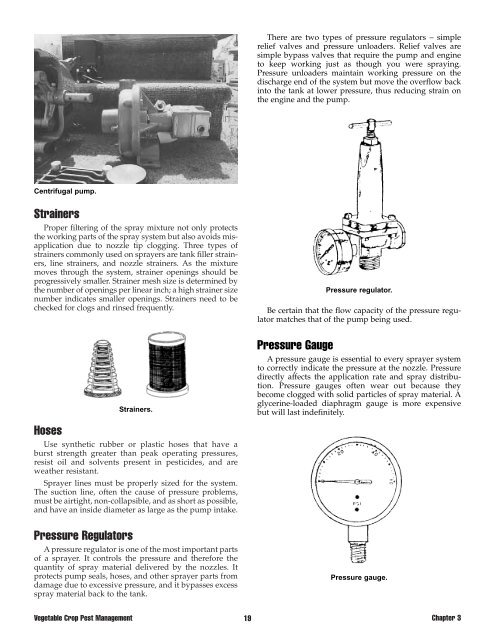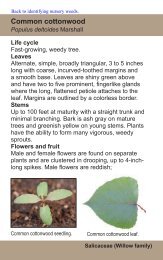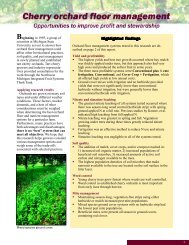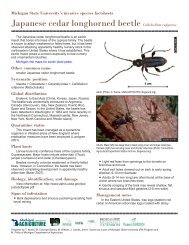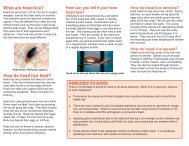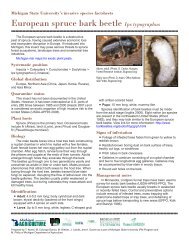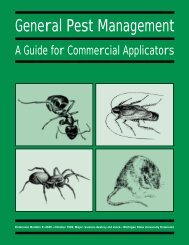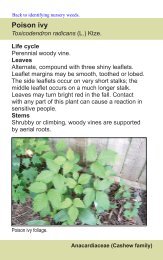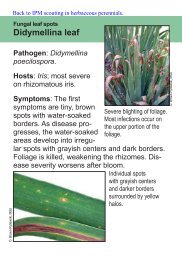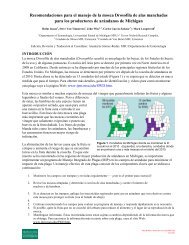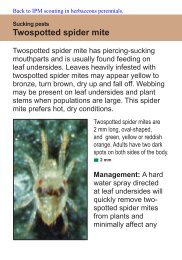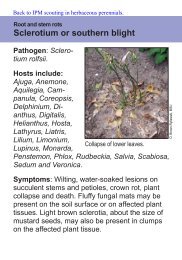Whole Manual - Michigan State University: Integrated Pest ...
Whole Manual - Michigan State University: Integrated Pest ...
Whole Manual - Michigan State University: Integrated Pest ...
Create successful ePaper yourself
Turn your PDF publications into a flip-book with our unique Google optimized e-Paper software.
There are two types of pressure regulators – simple<br />
relief valves and pressure unloaders. Relief valves are<br />
simple bypass valves that require the pump and engine<br />
to keep working just as though you were spraying.<br />
Pressure unloaders maintain working pressure on the<br />
discharge end of the system but move the overflow back<br />
into the tank at lower pressure, thus reducing strain on<br />
the engine and the pump.<br />
Centrifugal pump.<br />
Strainers<br />
Proper filtering of the spray mixture not only protects<br />
the working parts of the spray system but also avoids misapplication<br />
due to nozzle tip clogging. Three types of<br />
strainers commonly used on sprayers are tank filler strainers,<br />
line strainers, and nozzle strainers. As the mixture<br />
moves through the system, strainer openings should be<br />
progressively smaller. Strainer mesh size is determined by<br />
the number of openings per linear inch; a high strainer size<br />
number indicates smaller openings. Strainers need to be<br />
checked for clogs and rinsed frequently.<br />
Pressure regulator.<br />
Be certain that the flow capacity of the pressure regulator<br />
matches that of the pump being used.<br />
Strainers.<br />
Pressure Gauge<br />
A pressure gauge is essential to every sprayer system<br />
to correctly indicate the pressure at the nozzle. Pressure<br />
directly affects the application rate and spray distribution.<br />
Pressure gauges often wear out because they<br />
become clogged with solid particles of spray material. A<br />
glycerine-loaded diaphragm gauge is more expensive<br />
but will last indefinitely.<br />
Hoses<br />
Use synthetic rubber or plastic hoses that have a<br />
burst strength greater than peak operating pressures,<br />
resist oil and solvents present in pesticides, and are<br />
weather resistant.<br />
Sprayer lines must be properly sized for the system.<br />
The suction line, often the cause of pressure problems,<br />
must be airtight, non-collapsible, and as short as possible,<br />
and have an inside diameter as large as the pump intake.<br />
Pressure Regulators<br />
A pressure regulator is one of the most important parts<br />
of a sprayer. It controls the pressure and therefore the<br />
quantity of spray material delivered by the nozzles. It<br />
protects pump seals, hoses, and other sprayer parts from<br />
damage due to excessive pressure, and it bypasses excess<br />
spray material back to the tank.<br />
Pressure gauge.<br />
Vegetable Crop <strong>Pest</strong> Management 19<br />
Chapter 3


